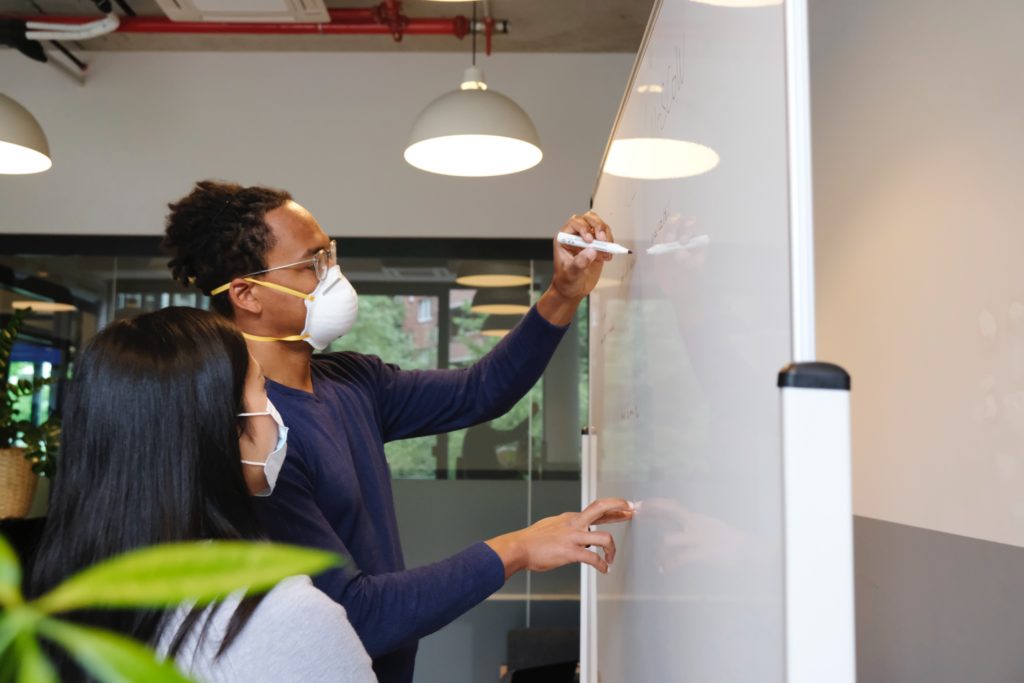Scenario planning: the what, how and why

Business continuity is in jeopardy. With organizations everywhere on high alert, can scenario planning minimize risk and equip your teams with the foresight to handle the unexpected?
In this volatile period, organizations should turn their attention to scenario planning. This is the focus on anticipating potential outcomes in the future – outcomes that can affect the business and its people.
But scenarios aren’t predictions. Scenario planning is the casting of the net in order to capture all possible futures. This covers the pandemic trends that could become permanent and the navigation around all potential risks and opportunities that lie ahead.
Communicating with staff during COVID-19
Scenario planning is a technique well-used in wars, and put to good use by companies like Shell, whose scenario team prepared them for cataclysmic events like the 1973 energy crisis, the more severe price shock of 1979, the collapse of the oil market in 1986, and the fall of the Soviet Union among others.
Of course, many of the narratives won’t happen – but without the benefit of hindsight, we don’t know which ones will or won’t. Therefore, careful consideration must be given to all plausible scenarios that lie on the horizon. And in a world-changing event like COVID-19, scenario planning might be one of your most valuable tools to deploy right now.
The three visions of the post-COVID world

Broadly speaking, the next five years poses three possible scenarios:
- Everything will change: the world enters a state of flux and a prolonged global recession. Many key industries collapse. Surviving markets are remodeled.
- Some things will change: Face-to-face interaction is no longer the norm. The majority of desk-based employees work from home. Some industries shrink.
- Nothing will change: After a period of recovery, air travel picks up, mass gatherings continue, and people return to offices.
The second possibility – that some things will change – is the most likely of the three. We come to this conclusion from the experience of past pandemics. However, scenario planning should consider all three eventualities, all the way from optimistic to pessimistic.
What possible scenarios do you need to plan for in your business?

Even in less turbulent times, leaders need to be mindful of their business models and adapt accordingly. Right now, we need to consider a range of plausible consequences that could follow in the wake of COVID-19.
Working from home becomes a permanent fixture – with huge corporations promoting remote working and closing up major offices; the future looks likely to embrace the merits of working from home more than ever before. This will see a shift in tech use, as the focus moves on to replicate the ease of communication and collaboration in the office. Task management, reporting, and time tracking software will also see considerable leaps in use. City centers will empty and demand for corporate real estate drops.
Global recession – Businesses preparing for an economic downturn will look to further restructuring as a way to cushion themselves for the bumpy ride ahead. As job retention programs come to a close, further job losses are expected. Spending drops and markets slow down. Most organizations will protect themselves by reducing overheads and stalling any major projects.
The collapse of key industries – Travel, tourism, oil and gas, retail, and the entertainment industries are currently on their knees and will suffer further problems over the next few months. Many will recover over time, and many may suffer from a shift in mindset, eg: a reduction in people taking air travel.
The departure of face-to-face interactions: This will mean an end to physical meetings, conferences, expos, and social gatherings. Businesses who focus on sales from physical meetings will need to make adjustments. Tech will experience a pressing demand to produce software for virtual meetings, both big and small.
Your business changing tack: If you’re involved with any industries that are heavily impacted by lockdown, there is a need to mitigate any further damage. A change in direction may be necessary, transferring your services or products to customers who carry less risk.
Communicating with staff during COVID-19
However, necessity is the mother of invention, and in times of adversity, there are also positive scenarios to be mindful of.
The creation of new industries: There will be other industries that are on the rise: namely, e-commerce, logistics, and software. Hardship often spurs enterprise and innovation, so new industries centered on people remaining at home will undoubtedly spring up. Products based on e-learning, virtual meetings, and pharmaceuticals are predicted to see huge boosts.
Improvements in health and medicine – there is a global race to file the first COVID-19 vaccine patent. Still, elsewhere around the world, medical experts are learning more about treating people in adverse circumstances and detecting diseases. These developments are helped by governments prioritizing healthcare, but also in individual care, as people consider their own personal choices in exercise, diet, and approaches to mental health.
Advancements in technology – In one of the industries flourishing during COVID, technology has proven pivotal in healthcare, and businesses that have had to modify their operations during lockdown. 3D printers previously used to manufacture aircraft parts have been used to create ventilators for hospitals. At the height of the outbreak in China, robots were used in and around Wuhan to deliver medicines, bedsheets, and rubbish to and from hospitals. Software companies have revisited their existing products and offered more refined versions for business and a domestic setting for communication purposes. This will continue as tech is used to move enterprises forward through the recovery stage.
Things return to normal: It is almost a certainty that things will return to some kind of normal. However, when this happens, remain uncertain. Some, going off vaccination distribution estimates, have penciled the winter of 2021. The worst recorded pandemic – and something that COVID-19 pales in comparison with – the Spanish Flu lasted just over two years, which could take us to the summer of 2022. But then there is the financial recovery aided by consumers adopting a bunker mentality and rising unemployment, which could take several years to overcome.
How to carry out strategic planning activities in your organization

First and foremost, all leaders need to be on board to support new strategies and changes in systems and processes. This period will test the mettle of organizations, and senior-level need to work together. As a result, teams need to be agile enough to support these shifts to make the necessary changes.
Generally speaking, this kind of planning usually thinks up four different scenarios, using a combination of geopolitics, economy, advances in technology, your current circumstances, and your future goals to govern your narratives. Given enough time, you and your team could dream up an infinite number of scenarios, and outlandish ideas should be welcome (after all, who would have believed twelve months ago that a pandemic and subsequent global shutdown would occur within the year?). Some of the main things to consider include:
Employees
If en masse remote working continues, do you have the resources to sustain it long term? Are there any productivity issues that have occurred during the move to working from home? Could your communication tools work harder to support your employees? If some or all of your workforce were to return to the office, is there anything that would pose a challenge in the transition back?
Communicating with staff during COVID-19
Product
With the service or product carry on with current levels of demand? How will supply chains be affected over the next 24 months? What competition do we and will we face? How advanced is the product/service – and how likely is it to be rendered obsolete or irrelevant?
The economy
How will an inevitable recession affect your business? What threat does global warming have? Is the current political climate posing any challenges to your organization? What supposed benefits and disadvantages will a change in government bring? Will oil prices rise or fall?
Your customers
Which of your customers are in industries identified as carrying the most risk? Are there customers in countries that face political turbulence that could affect business? Are second or third waves and subsequent lockdowns a possibility in the countries you do business in? Are there new sectors you should focus on?
At the very least, this type of planning allows you to focus on long term plans and enables you to be prepared when the unexpected happens rather than behave reactively.
The tools that help with scenario planning

Tools specific to scenario planning exist, but there are also a number of tools already in use that support scenario planning. Using an intranet as a basis (to connect employees, share ideas, convey crisis comms), there are other features within this kind of system that can help.
Communication tools: Of course, the central facet of scenario planning is communication. With dispersed colleagues, your business will already be incorporating platforms like Microsoft Teams, Skype for Business, and Yammer. Ensure the software you use allows you to hold one-to-ones, group talks, and company-wide gatherings to keep employees informed of changes in direction.
Feedback tools: While you’re leading the way, it’s essential you keep checking in with your employees and your customers to ensure they’re onboard, happy, and feel efficiently informed with the direction your organization is taking. Surveys and internal pulse features can help discover thoughts and feelings in a confidential setting.
Collaboration tools: With your colleagues dispersed, it’s vital that you’re still able to work and collaborate together. There are a large number of platforms that enable this, from G-suite to O365. Your chosen collaboration tools needs to cover communication, document sharing, and planning.
Forecasting tools: While a lot of strategic management is speculative, there are a number of services available that help you find, gather and analyze data. Demand Works and Tableau are well-used forecasting software. Even Quickbooks, the accountancy software, can help you access trend reports and forecasts based on your own profit and loss sheets.
Presentation tools: In order to communicate changes in strategy and new plans, you need to be able to present it effectively. While PowerPoint is the traditional go-to, there are a whole host of other services which provide more interactive graphics and fresh templates like Visme, Ludus and Beautiful.
The lessons we can learn from the past

While we consider the various scenarios that could unfold over the next few years, are there any lessons we can learn from past pendemics? Despite it being over a century ago, and in a very different world, there have been numerous comparisons with the present situation and the Spanish flu pandemic. There were several positive outcomes from the 1918 flu that some speculate could provide a similar blueprint to life post-COVID.
- A period of prosperity: After lockdowns, border control, and mask-wearing, transmissions dropped until the spread of the influenza was deemed over. What followed was a period of euphoria – the roaring twenties – where society and the economy enjoyed a post-war, post-pandemic boom.
- World-changing developments were spurred on: the development of public health programs were founded. This provided a more democratic approach to medicine and care across society – one that was previously weak and susceptible to disease.
- Population boom: From the aftermath of widespread illness and death sprung a smaller but healthier population and a subsequent baby boom. Usually attributed to the end of WW1, even neutral countries like Norway experienced a population increase, suggesting the pandemic had just as much to play.
However, it might not be such a good idea to compare COVID-19 to the Spanish Flu. Firstly, the influenza took place in a very different world – where countries with no healthcare or welfare systems in place were recovering from the calamitous effects of WW1. Secondly, the Spanish Flu was far deadlier than coronavirus: 50 million people died from the Flu, while 500 million people were infected. This is compared to the (figures correct at time of writing) 740,000 deaths and just over 20 million cases of COVID-19. Today’s virus is up against a healthier, stronger population with easier access to care and medicine.
In fact, there are outbreaks like the 1957 Asian flu and the 1968 Hong Kong flu, which are on a much similar scale to coronavirus. They were responsible for the deaths of about two million and four million people, respectively. Again this is more than today’s COVID figures – however, there is little reference to these pandemics, despite the more similar situations.
The consequences of these two events can be a source of some comfort. The world recovered from the 1957 and 1968 pandemics – to the point where they have almost become a footnote in history.
Perhaps COVID-19 may become similarly inconsequential in the passing of time, and we revert back to normal behaviors, while embracing better habits and shunning some less favorable attitudes.
But in the present moment, there is a need to look ahead, probe the future, and use scenario planning to prepare the organization for both the expected and the unexpected.

